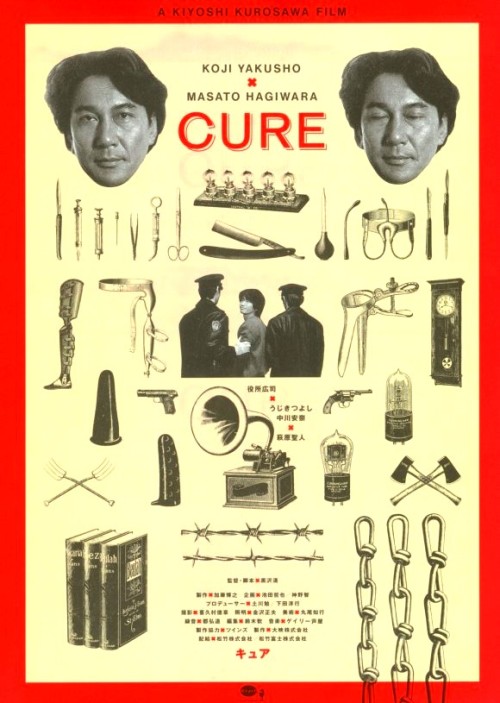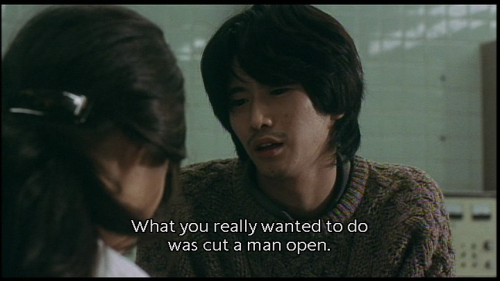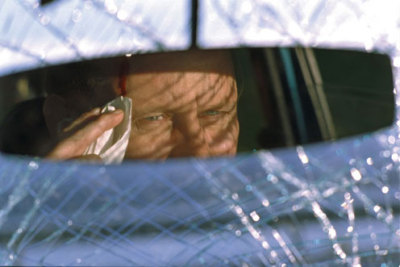Last Year at Marienbad centers on an unnamed man (Giorgio Albertazzi) who meets a woman (Delphine Seyrig) at a European resort. He insists that they met a year before, at a resort called Marienbad, but she replies that they've never seen each other. The man spends his time trying to recall and relay his vague memories to her, and she may or may not start to remember things as well. Yet, as the connection may be a passionate one, the man must also contend with the presence of a man (Sacha Pitoëff) accompanying the woman at this resort.
Carnival of Souls opens with a car accident, killing all but one woman, named Mary Henry (Candace Hilligoss). She escapes and tries to reintegrate herself into life, but disturbing characters follow her wherever she goes.
Both the unnamed man and Mary Henry are confused about the paths they are taking, and later on start to wonder about what actually motivated them on their journeys. The only people they manage some connection with are initially presented as possible romantic interests - the unnamed woman in Marienbad, and the sleazy neighbor John Linden (Sidney Berger) in Carnival. These relationships turn dark, and in each film,, the male character builds up to an aggressive pursuit of the female character. However, their actions may or may not be figments of a troubled imagination.
Carnival of Souls is, unmistakably, a B-movie, though it is one with enough qualities to endear it to many types of film fans. The ghastly people following Mary have faces caked with white makeup, eyes surrounded with black. Some of the townspeople seem to act normal, but their actions grow more odd every moment, and there is an eerie emptiness all around Mary.
In Last Year at Marienbad, the people at the resort are all elegant in dress and refined in manner. They stop moving and start moving, either accentuating the lead character's narration or illustrating the disjointed quality of his thoughts. The composition, beautifully photographed by Sacha Vierny, is sometimes harsh in its minimalism and rigid geometry. People and things becoming little more than shapes and echoed lines. Each films have the effect of a dream spinning into nightmare.
The soundtracks, and especially their use of organ music, add to this effect. Mary in Carnival is an organist, playing crazed, infernal compositions (by Gene Moore) when the mood strikes her. The rest of the soundtrack is also played on organ, except when tunes are played on a jukebox Marienbad composer Francis Seyrig uses the organ to create a stately yet ominous atmosphere with his music, such as when the movie opens with the main character's musings on the fading resort. On that tangent, locations in these films have both a stark beauty and an air of decay to them, from the ornate decor of that European resort to the haunting appearance of a ruined entertainment pavillion.
Last Year at Marienbad and Carnival of Souls are understandably polarizing films. Their plots can be frustrating, their looks can seem too affected, and their characters are sometimes unsympathetic or even detestable. Even for those more inclined to like these movies, it takes some time for each film's particular rhythms to set in. Yet it is interesting to compare these films for their alternate "high art"-"low art" treatments of stories told through the eyes of unreliable, alienated protagonists trying to make sense of the world. Both films aim to display feelings that cannot be competely articulated in words. They aim to be honest, in their own way; by showing these experiences as fractured and surreal, compelling and frightening for what they reveal.
Carnival of Souls is, unmistakably, a B-movie, though it is one with enough qualities to endear it to many types of film fans. The ghastly people following Mary have faces caked with white makeup, eyes surrounded with black. Some of the townspeople seem to act normal, but their actions grow more odd every moment, and there is an eerie emptiness all around Mary.
In Last Year at Marienbad, the people at the resort are all elegant in dress and refined in manner. They stop moving and start moving, either accentuating the lead character's narration or illustrating the disjointed quality of his thoughts. The composition, beautifully photographed by Sacha Vierny, is sometimes harsh in its minimalism and rigid geometry. People and things becoming little more than shapes and echoed lines. Each films have the effect of a dream spinning into nightmare.
The soundtracks, and especially their use of organ music, add to this effect. Mary in Carnival is an organist, playing crazed, infernal compositions (by Gene Moore) when the mood strikes her. The rest of the soundtrack is also played on organ, except when tunes are played on a jukebox Marienbad composer Francis Seyrig uses the organ to create a stately yet ominous atmosphere with his music, such as when the movie opens with the main character's musings on the fading resort. On that tangent, locations in these films have both a stark beauty and an air of decay to them, from the ornate decor of that European resort to the haunting appearance of a ruined entertainment pavillion.
Last Year at Marienbad and Carnival of Souls are understandably polarizing films. Their plots can be frustrating, their looks can seem too affected, and their characters are sometimes unsympathetic or even detestable. Even for those more inclined to like these movies, it takes some time for each film's particular rhythms to set in. Yet it is interesting to compare these films for their alternate "high art"-"low art" treatments of stories told through the eyes of unreliable, alienated protagonists trying to make sense of the world. Both films aim to display feelings that cannot be competely articulated in words. They aim to be honest, in their own way; by showing these experiences as fractured and surreal, compelling and frightening for what they reveal.
-- -
Carnival of Souls for Sample Theater is a blog covering a multimedia performance of the film's story.
For more on the sets and fashion of Last Year at Marienbad, here is a great collection of screencaps, as well as writings on the film.
Last Year at Marienbad can, at the moment, be found in its entirety on Youtube.
Carnival of Souls is in the public domain and can be viewed here.
For more on the sets and fashion of Last Year at Marienbad, here is a great collection of screencaps, as well as writings on the film.
Last Year at Marienbad can, at the moment, be found in its entirety on Youtube.
Carnival of Souls is in the public domain and can be viewed here.























